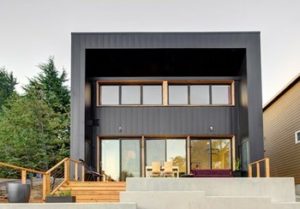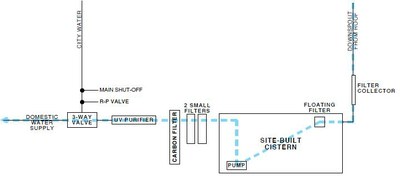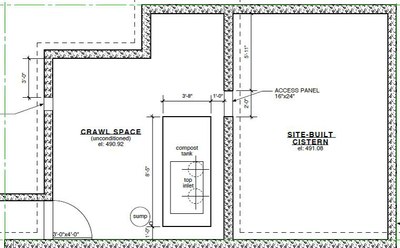Net Zero Water, Net Zero Energy Full Plane Passive House in Portland
Case Study: Published | Updated: | | Oregon, Portland | 197898- Category
- category_listing(s)
- Building Type
- Innovation
- Net-Zero Water
- Jurisdiction
- Oregon, Portland
- Parcel
- 197898
- Officials
- Charlotte Phillips | Building and Development Services
- Team
-
Charlotte Phillips
|
approving-official
Michelle Jeresek | Designer
James Ray Arnold | builder
Lisa Whitridge | owner

The Full Plane Passive House gives modern form and presence to the owner’s ecological and social values, while providing a playful environment for her son to grow and be educated in sustainable living in the City. To meet net-zero water goals she combined stormwater catchment, graywater irrigation for her living landscape and composting toilets. It all complied with Oregon’s statewide alternative water re-use plumbing rules adopted a decade before many other US Cities even considered it.
This project took full advantage of Oregon’s innovative policies regarding water collection and reuse to permit several complementary systems, through a mostly standard plan review process with the City of Portland with almost no issues. The underground cistern for harvesting rainwater for potable use was the only element that required a City code appeal, using a standardized appeal process authorized by Statewide Alternative Measure 08-01 in 2008, and following clear specifications defined in 2008 Oregon Specialty Plumbing Code (OSPC) Appendix M. The home’s graywater system, designed to reuse all wastewater from showers, sinks and dishwashing to irrigate an outdoor native garden, was approved by the City with the one requirement that they connect to city sewer for backup in case there was ever a problem with the distribution system. Composting toilets followed Oregon’s prescriptive rules in the 2008 OSPC allowing them as long as the model of toilet is an approved manufactured or site-designed toilet, tested and approved under National Sanitation Foundation (NSF) Standard 41.
| Code Requirement | Compliance Path |
|---|---|
| Potable Rainwater: Statewide Alternative Method 08-01 allowed potable use in accordance with 2008 OPSC Appendix M, through a code appeal. | Cistern for potable water was approved through a code appeal under ORS 455.060. Architect presented plans and supporting documents showing conformance with Appendix M. |
| Graywater Re-Use for landscape irrigation has been allowed since the 1980s under OAR 340-071. Oregon House Bill 2080 fully legalized it in 2009. | Required permit from Oregon Department of Environmental Quality was granted through standard review process which pre-dated DEQ regulation OAR 340-053-0050 |
| Composting Toilets OAR 918-770-0080allows use of composting toilet listed with NSF Standard 41, and conforming with materials, installation and inspection requirements | Clivus Multrum composting toilets (listed with NSF Standard 41) were approved through prescriptive compliance |
 Rainwater harvesting for potable and non-potable use, designed in conformance with OSPC Appendix M. Rainwater is captured from the 1,274 square foot standing seam metal roof surface, and routed through a leaf filter, then to an 11,000 gallon below-grade site-built concrete cistern The Cistern is sealed with a food grade engineered siloxane coating. Water from the cistern is drawn through a floating filter that ensures water is taken from the cleanest part of the cistern, filtered again for large particulate matter before being pumped through two in-line filters, which are transparent for easy viewing of filter cleanliness. Water is then routed through a larger carbon filter, and lastly through an ultraviolet purifier. (see attached cistern diagram and product brochures).
Rainwater harvesting for potable and non-potable use, designed in conformance with OSPC Appendix M. Rainwater is captured from the 1,274 square foot standing seam metal roof surface, and routed through a leaf filter, then to an 11,000 gallon below-grade site-built concrete cistern The Cistern is sealed with a food grade engineered siloxane coating. Water from the cistern is drawn through a floating filter that ensures water is taken from the cleanest part of the cistern, filtered again for large particulate matter before being pumped through two in-line filters, which are transparent for easy viewing of filter cleanliness. Water is then routed through a larger carbon filter, and lastly through an ultraviolet purifier. (see attached cistern diagram and product brochures). Graywater reuse for irrigation: All household wastewater and overflow stormwater from the cistern are distributed via subsurface irrigation to a series of swales and raingardens designed to slow the overland flow of water and promote infiltration, cascading down a 16% slope behind the house. Landscape zones include a kitchen garden close to the house, another ring with edible fruit trees, shrubs and flowering bee garden, to the outer ring toward the bottom of the hill where a future urban forest has been planted with native shrubs and conifer trees that provide food and nesting materials for butterflies, birds and other wildlife.
Graywater reuse for irrigation: All household wastewater and overflow stormwater from the cistern are distributed via subsurface irrigation to a series of swales and raingardens designed to slow the overland flow of water and promote infiltration, cascading down a 16% slope behind the house. Landscape zones include a kitchen garden close to the house, another ring with edible fruit trees, shrubs and flowering bee garden, to the outer ring toward the bottom of the hill where a future urban forest has been planted with native shrubs and conifer trees that provide food and nesting materials for butterflies, birds and other wildlife.